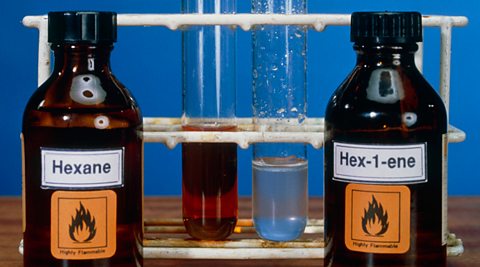Reactions of alkenes
Like the alkaneSaturated hydrocarbon. A compound of hydrogen and carbon only, with no C=C bonds., the alkeneUnsaturated hydrocarbon with a double bond between the carbon atoms. undergo combustionThe process of burning by heat.. However, alkenes are less likely to combust complete combustionBurning in a plentiful supply of oxygen or air. Complete combustion of a hydrocarbon produces water vapour and carbon dioxide., so they tend to burn in air with a smoky flame due to incomplete combustionBurning when there is a limited supply of air or oxygen..
Addition reactions of alkenes
The functional groupAn atom, or group of atoms, that determines the main chemical properties of an organic compound., C=C, allows alkenes to undergo addition reactions. For example, ethene reacts with bromine to form 1,2-dibromoethane:
CH2=CH2 + Br2 â CH2BrCH2Br
It is easier to see what happens using structures with all their covalent bondA bond between atoms formed when atoms share electrons to achieve a full outer shell of electrons.:
The reaction is an âadditionâ reaction because one moleculeA collection of two or more atoms held together by chemical bonds. combines with another molecule, forming one larger molecule and no other productA substance formed in a chemical reaction..
Alkanes cannot take part in addition reactions.
Worked example
Propene, CH3CH=CH2, reacts with bromine. Predict the structure of the product formed.
The structure will be: CH3CHBrCH2Br.
Question
But-1-ene, CH2=CHCH2CH3, reacts with bromine. Predict the structure of the product formed.
The structure will be: CH2BrCHBrCH2CH3.
Testing for alkanes and alkenes

An orange-brown solution of bromine dissolved in water, called bromine water, is used to distinguish between alkanes and alkenes:
- there is no change when bromine water is mixed with an alkane
- the bromine water becomes colourless when it is mixed with an alkene
Addition reactions with different reactants
Alkenes can react with different types of chemicals during addition reactions.
Alkene + hydrogen â alkane
This is called hydrogenationAn addition reaction in which diatomic hydrogen molecules are added across carbon to carbon double bonds., and it needs a catalystA person or thing that causes an event or change..
For example:
Propene + hydrogen â propane
Alkene + water (steam) â alcohol
This is called hydrationChemical reaction in which water reacts with a substance., and it needs a temperature of approximately 300°C and a catalyst.
For example:
Butene + water â butanol
Alkene + halogen â halogenoalkane
Chlorine, bromine or iodine can be added to an alkene. These reactions are usually spontaneous. Here are some examples:
Ethene + chlorine â dichloroethane
Ethene + iodine â diiodoethane